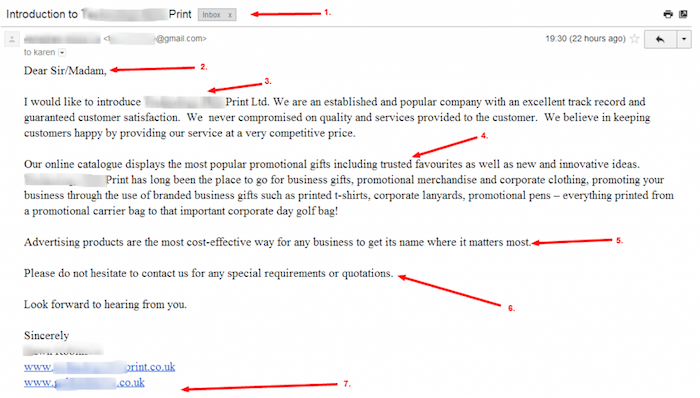Which of these 7 mistakes are you making in your email marketing?
I am sure you are a lot like me. Emails fly in; day in, day out. It feels that you are in constant battle with your inbox some days, doesn’t it?
Ever been tempted to “select all” and click “delete”? Huh … have you??
I know I have.
Emails are effective communication tools, but they can also strangle your productivity when you are trying to run your business as well your life.
So when you consider how most people feel about emails, why oh why do some businesses still think it’s OK to send out emails like this one?

This appeared in my inbox yesterday. Unsolicited, of course but being the marketing geek that I am, I was delighted to get it.
Not because I was interested in what they had to offer me, or that it provided perfect material for my swipe file. But that this email has given me a perfect case study to use to show you what NOT to do. The classic mistakes you may be making in your emails … right now.
Now I would hope that you wouldn’t be making ALL these mistakes. Cripes … if you did, you would probably be the type of business owner who is still blaming the Government for your lack of profits.
But I am pretty sure that you have made or will be making at least one of the gruesome marketing mishaps.
Here we go:
1. Subject Heading. The subject heading of your emails is the single most important part. Get it wrong and your carefully written email is gone with a single swipe of a finger across the screen of an iPhone.
Now that many people access their emails on the fly, it is too easy to delete, delete, delete so that when you finally do get in front of your PC you only have emails you want to deal with.
This particular business uses its business name in the subject heading, for goodness sake. Why oh why would anyone want to be introduced to XYZ Printing? Now you may not be using your business name but the most successful email subject heading to get you deleted is to use “Monthly Newsletter”. Blurgh … give your reader a compelling, exciting, secretive, curiosity reason for opening and reading more.
2. Personalisation. OK, so these guys may have the excuse of not knowing my name as they probably farmed my email address of some website. But the email address they farmed actually had my name in it!
Dear Sir/Madam doesn’t exactly have much warmth or sincerity to it, does it? If they wanted to be lazy, at least start the email with a simple “Hi” which would have been more in keeping to an email.
Personalisation works so make sure you use it in your emails. If you are using a reputable email marketing system such as aweber or mailchimp, then is it real easy to add the name merge code. And don’t just stick to the intro. Add their name once or twice in the copy and test using their name in your subject heading, from time to time.
3. First Line. If the subject heading grabs you to read more, then your first line in your email needs to pack a punch too. Too many people waffle on in the introductory paragraph but avoid this. Evoke curiosity. Give your reader a teaser of what is in store if they were to read on. Be controversial. Whatever emotion you are trying to evoke will depend on your objective of the email … but evoke an emotion fast or that finger will come a-swiping!
 4. Blah blah content. You can’t duller than this email but it is a common problem that many people face. Your latest news about a new member of staff, a new product range or winning an award may get you all stoked up … but to your reader they will merely shake their heads with a look of “Bothered?” on their faces.
4. Blah blah content. You can’t duller than this email but it is a common problem that many people face. Your latest news about a new member of staff, a new product range or winning an award may get you all stoked up … but to your reader they will merely shake their heads with a look of “Bothered?” on their faces.
It is way too easy to write about your business thinking it’s interesting. The chances are it is not and you have to write your email content for your reader … not for you.
5. Making half-hearted claims. I loved this line “Advertising products are the most cost-effective way for any business to get its name where it matters most.” Honestly … “any business?” “matters most?” Who comes up with this stuff?
Yes, they are selling promotional gifts so of course they think their products are great. But just telling me is frankly lazy. Far better to use case studies or testimonials … third party stories … to get your points across.
Take a look at how you “telling” people how great you are. Can you change your copy and write about the results your clients get instead?
6. The biggest marketing mishap. No CALL TO ACTION! They finish this particular email off with a “please do not hesitate to contact us”. Well, I’m sorry to burst your bubble but being polite and oh-so British about it, is going to get you nowhere.
Make an offer. Give your reader a compelling reason to drop everything that are doing right there and then and take action. Whether it’s clicking a link to a sales page, calling your special phone number or simply replying to the email … you have got to ask them to take action on something that is going to stop them in their tracks.
Expecting your reader to come back to your email at another time is not going to work. Emails come and go … very quickly! As soon as yours arrives, another 10, 20 or even 50 come piling in to steal your readers attention. Don’t let yours get buried; ending up in that folder that gets the “select all” and “delete” treatment.
7. Finally … No P.S. Now I am not saying that every successful email has to have a PS – but they do work!
Adding a final nudge about your call to offer under your name is a great way of making sure your message is clear and understood. As some people often scroll down to the bottom to see who has actually sent them the email, this always ensures your call to action is clear even to those who don’t actually the main body.


I agree and have to hang head in shame as we have all been guilty of this. The main issue for small companies is that we think we can do this job and try to save money by writing rubbish copy! I know as I have done it to. It’s hard sometimes to know what to say and we often lose the key messages by waffling on to fill the space – thanks for your helpful comments.
Thank you Alice. And delighted you have taken something away from reading this article. If you find it hard to know what to say, always ask yourself what your customers want to hear about. You run an amazing business … tea and coffee specialists.
If you want inspiration, take a look at Teapigs. I love their emails and how they communicate.You may not sell direct to the consumers as do Teapigs, but I am sure you have fanatic coffee lovers and tea addicts among your wholesale customers :O)
Nice article Karen, however I suggest you proof read and spell check your text before sending it out for the masses to read. I picked up several clangers of grammatical and spelling errors, which rather undermine your argument!
Thanks Tim. Yes, I put my hands up. I write as I talk and yes, I should get someone to proof read my writing but I find that can also slow down my pace at getting stuff done. When I am sitting at my kitchen table, after clearing up after the family supper – which is when I wrote both the email and this article – I find I do my best writing … but am also rather tired to pick up every little typo.
Better to complete than perfect IMHO
Fortunately, grammatical and spelling errors weren’t the subject of my article above!
I always notice grammatical and spelling errors – there are a lot of them about as everyone churns out content. On websites, in particular, I think it’s important to avoid them so as to make a good impression. It is, however, all too easy in this world we live in to jump to the mistakes and highlight those, rather than support one and other and appreciate the good parts. Let’s focus on the positives first and worry about the polishing touches second. I think the content here was interesting and useful. I don’t really send out emails in this way (Karen would probably say I’d better start!) but it is still food for thought.
I would agree for web content (and therefore with Phillippa below) and materials purchased but…this is a blog post so not so critical – also shows that the writer spoke from the heart and didn’t spend forever polishing or hire someone else to write it.
Also – from a business perspective – people buy from those they know, like and trust and so no-one who knows, likes and trust Karen (and we are very numerous) is going to be put off by some spelling/grammar errors.
Michael Port (author of Book Yourself Solid and other NYT best sellers) always concludes his communications with the words “spelling mistakes come free” or words to that effect so hey… we all make them – bet there’s some in this comment and I’ve re-read it twice already !!!
Hi Karen
Great article. I often get emails and direct mail and shake my head in horror. I am also very tempted to blog about how they have got it wrong or it could be improved.
I think you have missed a few mistakes in their email:
1. In their first paragraph they mistakenly used the past tense – we never compromised – suggesting they might now!
2. If you don’t know someone’s name and you start Sir/Madam the correct sign off is Yours faithfully, not sincerely
3. Unless you have blurred this they haven’t given their telephone number
4. If you were new to promotional gifts how would you know what the trusted favourites were?
I agree with everything you have said, and like to think I don’t churn out these clangers for my clients. However, I know only too well that being faced with a blank sheet of paper can be daunting for anyone, especially since for most copywriting is not their main job.
It does get easier the more you do it though. I write far better copy for clients now than I did five years ago!
Hey Nicky – thanks for your contribution. And yes, practice is everything. If I go back to my first few emails, they were quite awful. Very corporate sounding and stiff. It took me a while to learn that I could relax my writing and just be me.
Another ‘hits the spot’ blog post Karen.
Other comments I’d make about it are:
1) who says they’re trusted and popular ? if they included some testimonials from real firms then maybe they could make this claim
2) they’re actually spamming you so it may be smart to say something like “we’ve identified companies who may like to benefit from our printing services – hope you don’t mind us contacting you” – something more punchy but along those lines
That’s a great idea Gillian … takes the sting out of the thought it may be “spam”.
Excellent blog, Karen – thanks for the reminders…the marketing piece might also be improved by having an irresistible offer (what the prospect gets when they respond to your marketing piece, combined with what they have to do to get it – the offer is the inducement to take action NOW!) and some form of guarantee/risk reversal that serves to lower or eliminate risk – the natural consequence is more people will be inclined to buy from you. Agreed?
Agreed … although, kind sir, me thinks that your reference to the email as a “marketing piece” is too kind ;o)
Karen, this is a great article. I’m just about to send out my third ‘proper’ newsletter and was delighted to see that I’m not about to fall into any of your traps – I hope! I’ll be using this as a checklist every time. Thank you.
Good luck with your newsletters Katie. And delighted to know you aren’t sending them out as “Monthly Newsletter”.
Very useful article, Karen, which gets across your seven points powerfully — occasional grammar errors and all. You have a strong ‘voice’ which is conveyed in your conversational manner of writing. Both, I believe, suit the medium of email well. Which potential buyer would choose a grammatically flawless debate over a persuasively written and very clearly-made argument in between getting the kids ready for school, taking the car for service, and wondering what to give Johnny for his latest ailment? Thank you for providng me with an excellent email checklist!
Hi Jan – thanks for stopping by and great to “see” you again. Appreciate your comments – thank you!
Hi Karen,
Great article and I equally can’t stand emails like this, it’s even more annoying when you cannot unsubscribe for them!
Jade
makes hitting the spam button even more enjoyable :O)
Thanks Karen, a great article.
AND – a great example of a headline for YOUR post. It certainly got me to look.
Joy
Hi Karen
This is a brilliant way to draw attention to the important aspects of what NOT to do! Have you thought about contacting them to ask them what kind of response they get from their marketing and then to offer your super service to improve it (with a super fee to go with it of course!) – Stephanie
Hi Karen, I often finish with if you require further information……… and was a bit concerned about that. Thinking about it though I use it mostly when providing information on request or a booking so perhaps not too serious but will look out for it.
Also I need to look at using the ps’s as that is something I have never done!
Thanks for stopping by with your thoughts Jim. And have fun with your PS’s. Let me know what you end up using them for and how they work for you 🙂
I noticed as well the email was all me me me what’s great about me rather than what I can do for you, surely it would help more to talk more about what I can do for you in the email more specifically.